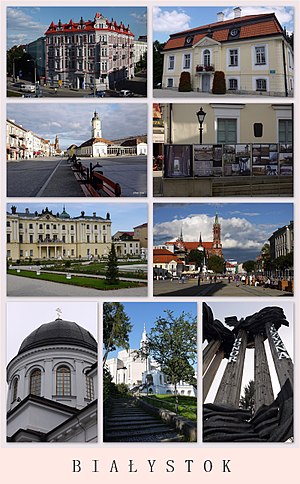Białystok

Białystok [bʲaˈwɨstɔk] ![]() (German veraltet Bjelostock, Yiddish ביאליסטאק Bjalistok, Belarusian Беласток Belastok) is the capital and only major city of the Polish Podlaskie Voivodeship.
(German veraltet Bjelostock, Yiddish ביאליסטאק Bjalistok, Belarusian Беласток Belastok) is the capital and only major city of the Polish Podlaskie Voivodeship.
Throughout its history, Białystok was a multilingual city. From the foundation of the city until the Second World War, Jews often constituted the majority of the population. From the mid-19th to the beginning of the 20th century, a numerically significant German minority also existed here. Today, Belarusians are the largest minority in the city.
Białystok is located in a fertile rural region. In the 19th and 20th centuries, the city became a centre of engineering and the electrical, metal and beer industries. It is located on the railway line from Warsaw towards Kaunas/Vilnius (Rail Baltica). There are several universities in Białystok. The city is the seat of a Catholic archbishopric.
Geography
Geographical position
Białystok is located about 180 km northeast of the national capital Warsaw near the Belarusian border on the small river Biała, which flows into the Supraśl in the northwest of the city, which in turn flows into the Narew a few kilometers further west.
Climate
| Monthly average temperatures and precipitation for Białystok
Source: wetterkontor.de | ||||||||||||||||||||||||||||||||||||||||||||||||||||||||||||||||||||||||||||||||||||||||||||||||||||||||||||||||||||||||||||||||||||||||||||||||||||||||||||||||||||||||||||||||||||||||||||||||||||||||||||||||||||||||||||||||||||||||||||||||||||||||||||
History
Białystok was first mentioned in documents in the 16th century. From 1665 it belonged to the Branicki family, who developed it into a residential town. At the instigation of Stefan Branicki, Białystok was granted town charter in 1692, which was renewed by August III in 1749.
Białystok and its surroundings came under Prussian rule in 1796 and after the Peace of Tilsit (1807) fell to Russia as Белосток/Belostok. This circumstance and the establishment of a customs border between Congress Poland and Russia in 1831 caused the town to boom. The customs border ensured that factories from Poland moved their headquarters to the now Russian Białystok (Belostok) in order to continue producing for the Russian army. The opening of the Warsaw-Petersburg railway, which passed through Białystok, made the city an industrial centre. With industrialization in the mid-19th century, a significant German minority formed, numbering about 12,000 in 1885, but declining in the following decades: in 1913 there were only 5,000 Germans in Białystok, and 2,500 in 1935. In 1900, 63% of the inhabitants were Jews, so the city also developed as a significant Jewish center. During World War I, a German air raid on Białystok took place on 20 April 1915, which resulted in 13 dead and 34 injured. Heavy damage was caused by Russian troops when they retreated from the advancing Germans on 13 August 1915. The city remained under German control from then until 19 February 1919.
After World War I, Białystok became part of the Second Polish Republic and from 1919 to 1939 was the capital of the voivodeship of the same name.
Shortly after the beginning of World War II, the city was captured by German troops in mid-September 1939 as part of the invasion of Poland, but according to the secret agreement in the German-Soviet Non-Aggression Pact, it was handed over to the troops of the Soviet Union on 22 September 1939 (official name Беласток/Belastok). In the course of the German attack on theSoviet Union, which began on 22 June 1941, Białystok was again occupied by the Wehrmacht; on 27 June 1941, the German Police Battalion 309 burned down the Great Synagogue of Białystok, to which they had previously herded hundreds of Jews. The new rulers established the Bialystok district and the Białystok ghetto here. Most of the 43-60 thousand Jewish inhabitants were sent to the extermination camps Treblinka and Auschwitz and murdered there. Białystok was the official residence of the Chief of the Civil Administration and the Commander of the Security Police and SD, who commanded the subordinate commanders (KdS) and Einsatzgruppen of the Security Police and SD.
At the end of July 1944, the city was captured by the Red Army. It was initially planned to incorporate the city, together with the western part of the former voivodeship, into the Soviet Union. Since 1945 it has belonged to Poland and, after having been the seat of the voivodeship of the same name until 1998, has been the capital of the Podlaskie Voivodeship (województwo podlaskie) since the reform of Poland's public administration in 1999.
Questions and Answers
Q: What is Białystok?
A: Białystok is the largest city in northeastern Poland and is the capital of the Podlaskie Voivodeship. It is located in the Podlaskie Plain on the banks of the Biała River in the Podlaskie region, known collectively as the Green Lungs of Poland.
Q: When was its city charter established?
A: The city charter dates back to 1692.
Q: How long has settlement activity been taking place in this area?
A: Settlement activity in this area dates back to the 14th century.
Q: What makes it an important economic center?
A: Its location near Belarus, Lithuania and Russia with convenient transportation connections creates excellent conditions for economic and cultural development of the city.
Q: What characterizes Bialystok?
A: Its openness, friendliness and hospitality characterize Bialystok due to centuries of people from different cultures, religions and nationalities living together there.
Q: How does it rank among other cities in Poland?
A: Among cities of Poland, Białystok is second in terms of population density, eleventh in population, and thirteenth in area.
Q: What constitutes Metropolitan Bialystok?
A: The city and its adjacent municipalities constitute Metropolitan Białystok.
Search within the encyclopedia